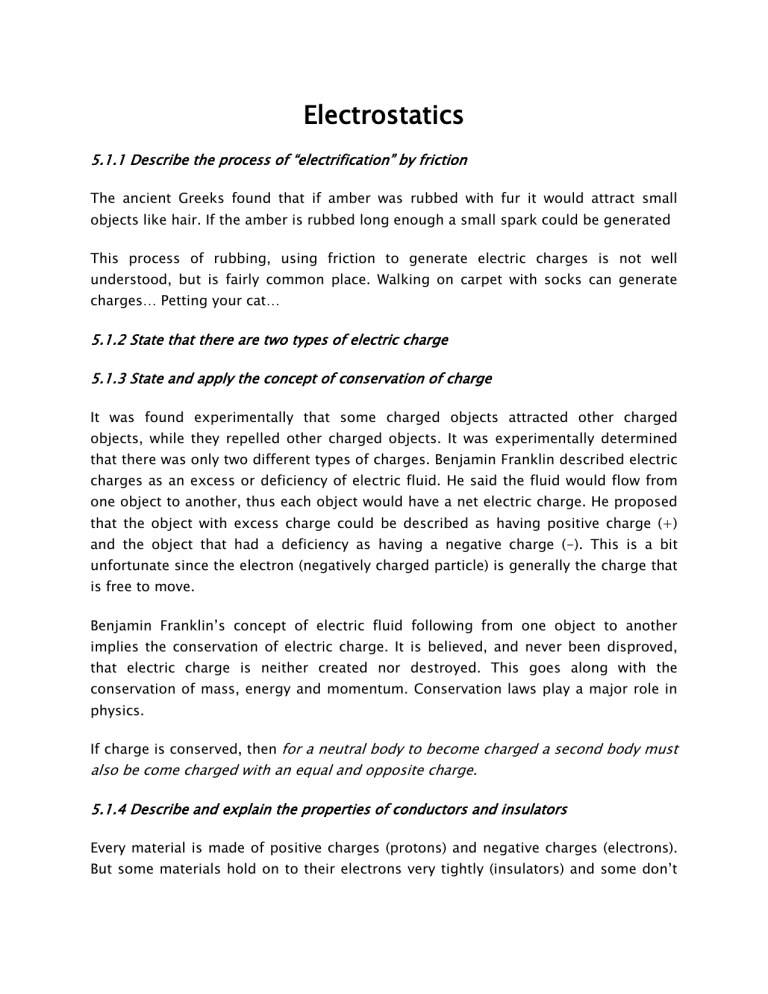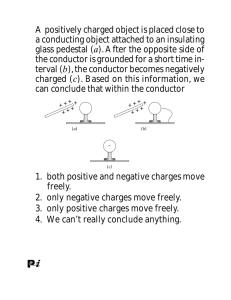Electrostatics

Electrostatics
5.1.1 Describe the process of “electrification” by friction
The ancient Greeks found that if amber was rubbed with fur it would attract small objects like hair. If the amber is rubbed long enough a small spark could be generated
This process of rubbing, using friction to generate electric charges is not well understood, but is fairly common place. Walking on carpet with socks can generate charges… Petting your cat…
5.1.2 State that there are two types of electric charge
5.1.3 State and apply the concept of conservation of charge
It was found experimentally that some charged objects attracted other charged objects, while they repelled other charged objects. It was experimentally determined that there was only two different types of charges. Benjamin Franklin described electric charges as an excess or deficiency of electric fluid. He said the fluid would flow from one object to another, thus each object would have a net electric charge. He proposed that the object with excess charge could be described as having positive charge (+) and the object that had a deficiency as having a negative charge (-). This is a bit unfortunate since the electron (negatively charged particle) is generally the charge that is free to move.
Benjamin Franklin’s concept of electric fluid following from one object to another implies the conservation of electric charge. It is believed, and never been disproved, that electric charge is neither created nor destroyed. This goes along with the conservation of mass, energy and momentum. Conservation laws play a major role in physics.
If charge is conserved, then for a neutral body to become charged a second body must also be come charged with an equal and opposite charge.
5.1.4 Describe and explain the properties of conductors and insulators
Every material is made of positive charges (protons) and negative charges (electrons).
But some materials hold on to their electrons very tightly (insulators) and some don’t
really hold on at all (conductors). All materials can be ionized, have some or all of their electrons removed, but it is much more difficult for some materials than others.
Most non-metals are insulators. Rubber or plastic is frequently used to electrically insulate an object. In an insulator the electrons are associated with specific protons
(nuclei) and are not free to move.
Metals are very good examples of conductors. A metal can be viewed as positive charges in a sea of electrons. The electrons are free to flow and move, they are not fixed rigidly to the protons. As the electrons “flow” the metal will retain a neutral charge.
5.1.5 Describe and explain the process of electrostatic induction
If a positively charged object is brought near to a conducting material the charges in the conductor will move, part of the conductor near the positively charged object is negatively charged and the part far from the positively charged object is positively charged. This is because opposite charges attract and like charges repel. In a metal only the negatively charged electrons are free to move, as the electrons flow to one side the opposite side is left with a deficiency of negative charges and has a positive charge, if the conductor is then grounded (or earthed) the free flowing electrons will then flow out leaving the conductor with a net positive charge. After grounding the original positively charged object can be removed and the charge on the conductor remains. We say that the conductor has been charged by the process of electrostatic induction.
5.1.6 Describe the use of the gold leaf electroscope
I don’t want to. Look it up or take your own freaking notes. :)
5.1.7 State Coulomb’s Law
Coulomb’s Law is a mathematical description of the force between two electrically charged objects. The form of Coulomb’s law is very similar to Newton’s law of universal gravitation. It should be noted that gravity is always attractive (only one mass charge), but electrical forces can both attract and repel (two charges). Coulombs law can be written in two different forms:
Where q1 and q2 are the charges, r is the distance between the charges, and ε is the electric permittivity of a material. Often ε is shown as εo, where the “knot” designates a vacuum.
If the charges are not in a vacuum, the permittivity of the material needs to be known.
Coulomb’s law can also be written in the form:
5.1.8 Apply Coulomb’s Law
Application of Coulomb’s law is plug and chug if there are only two charges (also assuming they are point charges). If there are more than two charges it becomes a bit more difficult. Since force is a vector and vectors add, we can find the force on a charge due to each other charge and then simply add the force vectors.
5.1.9 Define electric field
An electric field is a region in space in which another charged particle will experience a force. Electric fields are vector quantities they have both magnitude and direction. The electric field strength (or magnitude of the electric field) is defined as the force per unit charge or:
The units of electric field are NC −1 (Newton’s per Coulomb) or Vm −1 (Volts per meter). We will define a Volt when we define electric potential.
Why do we bother to define an electric field? It allows us to describe the force that a charged particle would feel at any given point if we were to place it in the field. The electric field allows us to do this only knowing the charge generating the field, to know the actual force we need to know both or all charges involved.
Often an electric field will exist and we are interested in the force a particle would feel if it was placed there. In this case we talk about using or placing a test charge at a given point in the electric field. If a test charge q is placed in an electric field E then the charge will feel a force .
5.1.10 Determine the electric field due to one or more point charges
5.1.11 Draw and explain electric field patterns for different charge configurations
Electric fields can be visualized by drawing lines of force, very similar to gravitational field lines. For example…
Electric field for a single positively
Electric field for a single negatively charged particle. charged particle.
Rules for drawing electric field lines:
1.
They start on a positive charge and end on a negative charge
2.
They meet electrostatically charged particles at a right angle.
3.
They never cross over one another
4.
Their density is an indication of their strength
5.
There is no electric field in a hollow conductor
5.1.12 Define the electric potential energy difference between two points in an electric field
5.1.15 Define electric potential difference (Yes I know its out of order)
If an electric charge is moved in an electric field work is done on the charge. There is an electric force and the your displacing the charge…
To arrive at an equation for the electric potential we do the exactly as we did for gravitational potential, i.e. we need to employ a little calculus.
If we move a positive charge q1 from infinity towards a stationary positive charge q2 to the point R, we are applying a force on q1, but the displacement is in the opposite direction, so we need a negative sign…
The last equation gives us an expression for the work done. From this we can say that two charges q1 zand q2 when separated by a distance r have the potential energy equal to:
The electric potential is defined as the potential energy per unit charge:
The units of electric potential is Volts, this is the same unit we talk about in terms of electric circuits. Potential is always measured between two points in an electric field or relative to something. When we say the power in the sockets is 220 volts, we mean relative to ground…We can only measure relative difference in potential, we can not measure absolute potential.
It is important to notes:
1.
Electric potential, like gravitational potential, is a scalar.
2.
The potential from multiple sources adds.
5.1.13 Determine the change in potential energy or change in kinetic energy when a charge moved between two points at different potentials
From the definition of potential we can define electrical potential energy in terms of the potential and the charge that is being moved:
(14)
Ep = Vq
If the charged particle is moved from a point with potential V1 to a point with potential
V2, then we can define the potential difference:
(15)
V = V 2− V 1
Since we can only measure potential differences we can use the same symbol for electric potential as for electric potential difference.
Therefore the change in potential energy is:
(16)
Δ Ep =( V 2− V 1) q = Vq
If a particle can gain potential energy, then this energy can be released by accelerating the charged particle through the potential difference. The potential energy can be completely converted to kinetic energy. The change in potential energy due to moving from potential V1 to potential V2 is equal to the change in kinetic energy of the particle accelerating from potential V2 to potential V1. So we can say:
(17)
Δ Ek = Vq
5.1.14 Define the electronvolt
An electronvolt is the amount of energy that one electron would gain by moving through a potential difference of 1 volt.
(18)
1 eV =1.6×10^−19 J
It is a very small unit of energy. We often talk about MeV, or megaelectronvolts.
Source: http://ibphysicsstuff.wikidot.com/electrostatics


